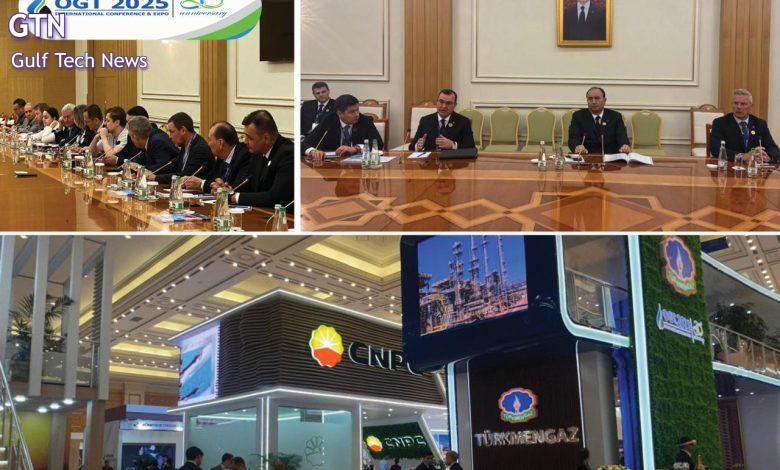During OGT 2025… Growing Investment Appeal & Negotiations with CNPC and ADNOC to Develop the Galkynysh Field

The Oil and Gas of Turkmenistan (OGT 2025) Conference and Exhibition, which concluded yesterday in the capital Ashgabat, achieved remarkable outcomes that impressed observers and participants from international energy companies and governments.
The results of the exhibition reflected Turkmenistan’s growing investment attractiveness and served as a strong catalyst for forming long-term, mutually beneficial partnerships between the national energy sector and global industry leaders.
At the same time, Maksat Babayev, Chairman of the state-owned company Turkmengaz, confirmed during a press conference that the company continues to implement major gas projects, including the development of the Galkynysh field and participation in the TAPI gas pipeline project (Turkmenistan–Afghanistan–Pakistan–India).
Meanwhile, Guvanch Agajanov, Chairman of the State Concern Turkmennebit, revealed the recent signing of a memorandum of understanding with Petronas regarding seven exploration blocks during an investment forum held in Malaysia, which is currently under implementation.
He also noted that another memorandum of understanding had been signed with the UAE-based Dragon Oil for the development of Block 19, with negotiations underway for further cooperation.
Strong and Influential Participation
Experts highlighted the broad participation of more than 1,400 delegates from 70 countries in the conference and exhibition, including 100 exhibiting companies joining for the first time from the energy sector.
The event enjoyed extensive international media coverage, enhancing Turkmenistan’s position in the global energy sector and strengthening its energy diplomacy and attractiveness. The event’s theme — “Energy. Innovation. Growth.” — and its focus on innovation, energy transformation, and strategic cooperation aligned closely with global energy trends.
Observers emphasized that hosting this important 30th edition demonstrated Turkmenistan’s continued role as an active player in regional and global energy cooperation and investment. The forum opened new horizons for foreign companies, technology transfer, and infrastructure support in both the upstream and downstream sectors, thereby enhancing the country’s ability to diversify and strengthen its oil and gas resources.
Regarding regional energy cooperation, the event encouraged cross-border links (such as the Caspian Sea and Central Asia), joint ventures, and the integration of new technologies — all of which improve supply security and infrastructure resilience.
Innovation: The New Face of Energy
On the topic of international dialogue regarding energy transition, the forum reflected Turkmenistan’s engagement with innovation, decarbonization, and hybrid energy systems — key elements for the country’s future. The strong turnout of companies and new participants in the business and investment environment indicates growing confidence in Turkmenistan as an ideal destination for energy projects and partnerships.
Observers noted that the sessions covered both traditional hydrocarbons and emerging topics such as underground gas storage, carbon capture, and renewable energy integration. The event served as a bridge between regional energy developments (Central Asia) and global energy transition dialogues.
It went beyond presentations — focusing on deal-making, business networking (through the AI-powered BusinessConnect platform), and partnership-building. For example, the Abu Dhabi National Oil Company (ADNOC) and its subsidiary XRG leveraged OGT 2025 to boost investments and participation in Turkmenistan’s gas sector.
Third Phase Negotiations
During a press conference announcing the results of the Oil and Gas of Turkmenistan 2025 Conference in Ashgabat, Babayev stated:
“Negotiations are ongoing with China National Petroleum Corporation (CNPC) regarding the second phase of the Galkynysh field development, designed to produce 30 billion cubic meters of commercial gas annually. Discussions are also underway with Abu Dhabi National Oil Company (ADNOC) concerning the third development phase, which is designed to produce 33 billion cubic meters per year.”
Babayev added: “We are also interested in developing gas chemistry projects, including import substitution and expanding export potential.” He clarified that the TAPI project is currently under technical study, with core agreements already signed with the participating governments, and the necessary intergovernmental documentation prepared.
He announced: “Work has been underway since September last year on the first segment of the gas pipeline in Afghanistan — a 150-kilometer section leading to Herat city. The TAPI project holds strategic importance, and we are exploring opportunities for further investment in its development.”
Turkmennebit and Oil Industry Modernization
For his part, Guvanch Agajanov, Chairman of Turkmennebit, stated that Turkmenistan’s national program for economic development — which includes modernizing the oil industry and introducing innovative technologies — is under active implementation.
Agajanov, who participated in the press conference, added that upgrading equipment and adopting modern technologies will allow for a 5–10% annual increase in oil production. He emphasized that foreign direct investment is welcomed as part of the country’s investment policy, particularly in the Turkmen sector of the Caspian Sea.
Agajanov revealed that a memorandum of understanding was recently signed with Petronas covering seven exploration areas during an investment forum held in Malaysia, and that implementation is already underway. He also confirmed the signing of another memorandum with Dragon Oil (UAE) for the development of Block 19, with ongoing negotiations for further collaboration.


